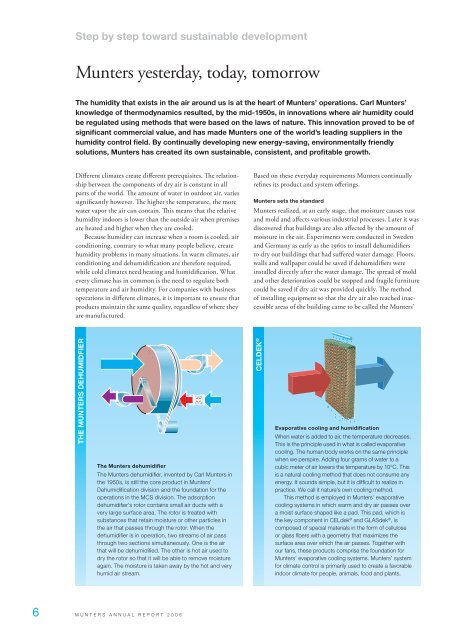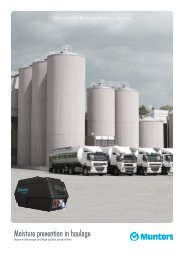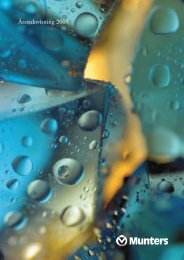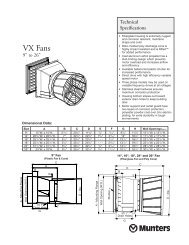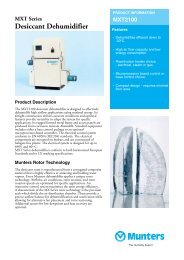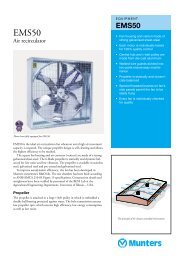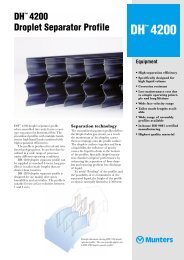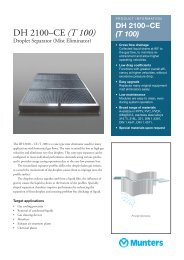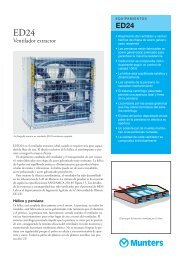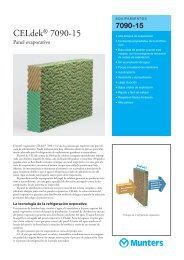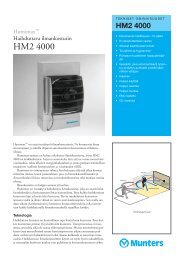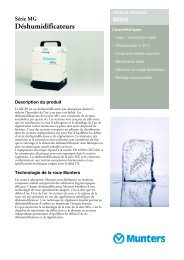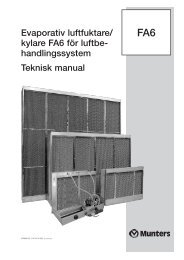Annual Report 2006 - Munters
Annual Report 2006 - Munters
Annual Report 2006 - Munters
Create successful ePaper yourself
Turn your PDF publications into a flip-book with our unique Google optimized e-Paper software.
Step by step toward sustainable development<strong>Munters</strong> yesterday, today, tomorrowThe humidity that exists in the air around us is at the heart of <strong>Munters</strong>’ operations. Carl <strong>Munters</strong>’knowledge of thermodynamics resulted, by the mid-1950s, in innovations where air humidity couldbe regulated using methods that were based on the laws of nature. This innovation proved to be ofsignificant commercial value, and has made <strong>Munters</strong> one of the world’s leading suppliers in thehumidity control field. By continually developing new energy-saving, environmentally friendlysolutions, <strong>Munters</strong> has created its own sustainable, consistent, and profitable growth.Different climates create different prerequisites. The relationshipbetween the components of dry air is constant in allparts of the world. The amount of water in outdoor air, variessignificantly however. The higher the temperature, the morewater vapor the air can contain. This means that the relativehumidity indoors is lower than the outside air when premisesare heated and higher when they are cooled.Because humidity can increase when a room is cooled, airconditioning, contrary to what many people believe, createhumidity problems in many situations. In warm climates, airconditioning and dehumidification are therefore required,while cold climates need heating and humidification. Whatevery climate has in common is the need to regulate bothtemperature and air humidity. For companies with businessoperations in different climates, it is important to ensure thatproducts maintain the same quality, regardless of where theyare manufactured.Based on these everyday requirements <strong>Munters</strong> continuallyrefines its product and system offerings.<strong>Munters</strong> sets the standard<strong>Munters</strong> realized, at an early stage, that moisture causes rustand mold and affects various industrial processes. Later it wasdiscovered that buildings are also affected by the amount ofmoisture in the air. Experiments were conducted in Swedenand Germany as early as the 1960s to install dehumidifiersto dry out buildings that had suffered water damage. Floors,walls and wallpaper could be saved if dehumidifiers wereinstalled directly after the water damage. The spread of moldand other deterioration could be stopped and fragile furniturecould be saved if dry air was provided quickly. The methodof installing equipment so that the dry air also reached inaccessibleareas of the building came to be called the <strong>Munters</strong>’THE MUNTERS DEHUMIDFIERThe <strong>Munters</strong> dehumidifierThe <strong>Munters</strong> dehumidifier, invented by Carl <strong>Munters</strong> inthe 1950s, is still the core product in <strong>Munters</strong>’Dehumidification division and the foundation for theoperations in the MCS division. The adsorptiondehumidifier’s rotor contains small air ducts with avery large surface area. The rotor is treated withsubstances that retain moisture or other particles inthe air that passes through the rotor. When thedehumidifier is in operation, two streams of air passthrough two sections simultaneously. One is the airthat will be dehumidified. The other is hot air used todry the rotor so that it will be able to remove moistureagain. The moisture is taken away by the hot and veryhumid air stream.CELdek ®Evaporative cooling and humidificationWhen water is added to air, the temperature decreases.This is the principle used in what is called evaporativecooling. The human body works on the same principlewhen we perspire. Adding four grams of water to acubic meter of air lowers the temperature by 10°C. Thisis a natural cooling method that does not consume anyenergy. It sounds simple, but it is difficult to realize inpractice. We call it nature’s own cooling method.This method is employed in <strong>Munters</strong>’ evaporativecooling systems in which warm and dry air passes overa moist surface shaped like a pad. This pad, which isthe key component in CELdek ® and GLASdek ® , iscomposed of special materials in the form of celluloseor glass fibers with a geometry that maximizes thesurface area over which the air passes. Together withour fans, these products comprise the foundation for<strong>Munters</strong>’ evaporative cooling systems. <strong>Munters</strong>’ systemfor climate control is primarily used to create a favorableindoor climate for people, animals, food and plants. M U N T E R S A N N U A L R E P O R T 2 0 0 6


